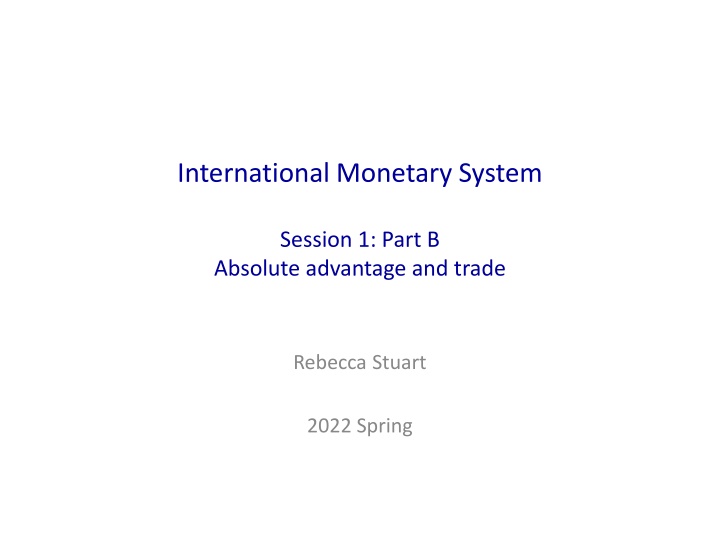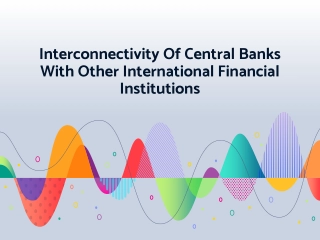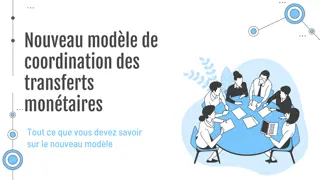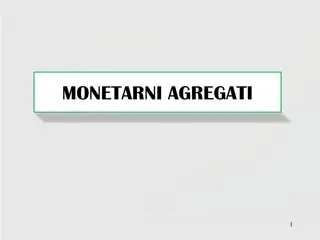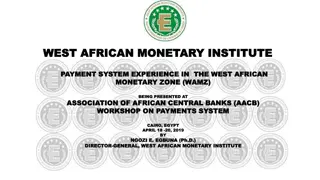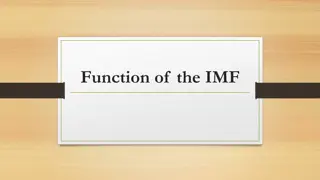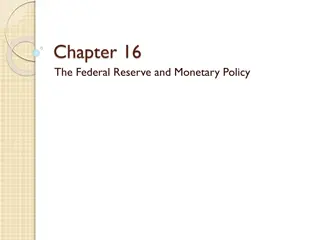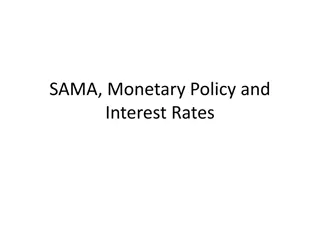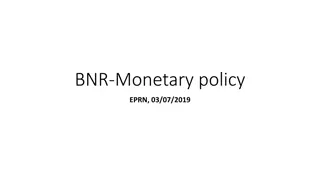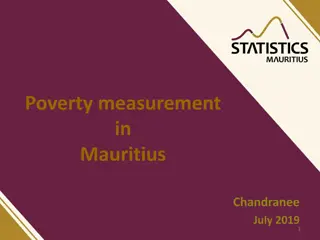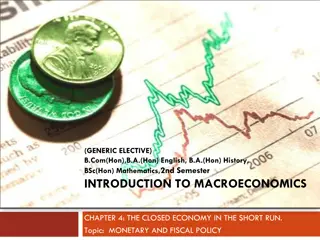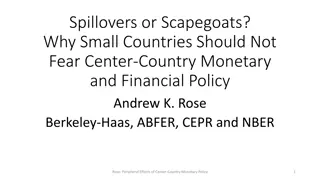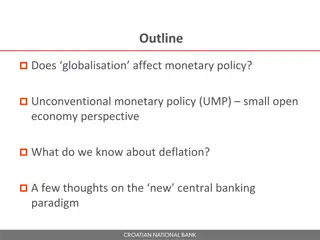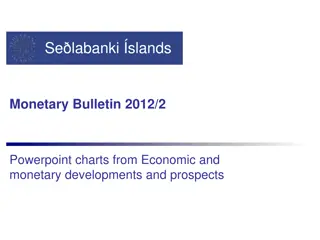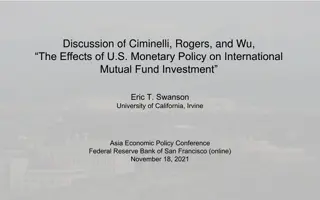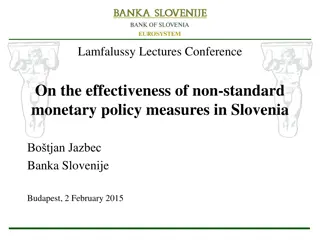International Monetary System
The session delves into trade theories, focusing on Mercantilism and Free Trade Theories, such as Absolute Advantage and Comparative Advantage. It explores concepts like the division of labor, wealth measurement, and gains from trade, emphasizing the benefits of specialization and debunking zero-sum notions in international trade.
Download Presentation

Please find below an Image/Link to download the presentation.
The content on the website is provided AS IS for your information and personal use only. It may not be sold, licensed, or shared on other websites without obtaining consent from the author.If you encounter any issues during the download, it is possible that the publisher has removed the file from their server.
You are allowed to download the files provided on this website for personal or commercial use, subject to the condition that they are used lawfully. All files are the property of their respective owners.
The content on the website is provided AS IS for your information and personal use only. It may not be sold, licensed, or shared on other websites without obtaining consent from the author.
E N D
Presentation Transcript
International Monetary System Session 1: Part B Absolute advantage and trade Rebecca Stuart 2022 Spring
Todays objectives Overview of trade theories Productivity as labour intensity Production possibility frontiers Opportunity costs and relative prices Gains from trade Note: all pictures taken from wikipedia 2
Trade theories Mercantilism o Trade is a zero sum game: There are always winners and losers o To win, one needs a trade surplus Free Trade Theories o Trade is a positive sum game: Specialization of production and free flow of goods benefit all trading partners economies. o Two main theories: Absolute Advantage (Adam Smith 1776) Comparative Advantage (David Ricardo 1817) o And several refinements: Factor-proportions (Eli Heckscher and Bertil Ohlin, 1919) Specific factor model (Paul Samuelson and Ronald Jones, 1971) Standard model of trade (Paul Krugman) combination of the above 3
Trade theories Mercantilism (1/1) Dominant theory of trade in Europe during the 16thto 18thcentury Basic Idea: The gain by one country is the loss of another (trade is a zero-sum game) o Wealth is measured in gold and gold is a limited resource. Safety/Influence: Exports gold army power Multiplier effect: Gold inflow increased domestic demand more jobs & higher profits higher domestic well-being We must always take heed that we buy no more from strangers than we sell them, for so should we impoverish ourselves and enrich them. Accumulate monetary reserves by maintaining a trade surplus o Encourage exports o Discourage imports Consequences: o High prices for domestic (no competition) and foreign products Notion of zero-sum in trade is present in many of today s protectionist views Queen Elizabeth I., 1558-1603 4
Division of labour is limited by the size of the market. Trade theories Free trade critique of mercantilism (1/1) Adam Smith, 1723-1790 Introduced by Adam Smith in The Wealth of Nations Formulated as explicit critique of mercantilism o Wealth is not measured in gold, but in the produce of land and labor (=GDP) o Mercantilism does not maximize GDP, because: Reduces competition Creates monopolies Distorts prices Reduces trade and specialization Reduces the overall variety of goods available o Gains from trade come from specialization not from inflow of gold International division of labor allows each country to produce more of what it is best at specialization Nature of trade is mutually beneficial, not zero sum o Consumption is the ultimate goal of economic activity, not production But mercantilism favors producers at the cost of consumers Thought experiment: Why not export 100% of produce and import nothing? 5
Trade theories Absolute Advantage (1/10) Absolute advantage: Ability to produce a greater amount of otherwise identical goods using the same amount of resources. Countries should specialize in the production of goods for which they have an absolute advantage and then trade these goods for goods produced by other countries. Example: Kg per worker and hour Chocolate Haribo Switzerland 10 20 Germany 5 50 o Switzerland has an absolute advantage in producing chocolate. o Germany has an absolute advantage in producing Haribo. o Switzerland should export chocolate to Germany and import Haribos from Germany. 6
Trade theories Absolute Advantage (2/10) A one-factor economy Assumptions: o Only two economies (CH and DE) o Only two goods (Chocolate and Haribos) o Only one production factor: labour Countries differ in productivity Labour intensity: labour required for the production of one unit of a good o Notation for good ?: ??? o Example (for Switzerland) 1 10(it takes a worker 1/10 of an hour to produce 1kg of chocolate) Haribo: ???= 20 Chocolate: ???= 1 7
Trade theories Absolute Advantage (3/10) Production possibility frontier (PPF) Definition: maximum combinations of goods that can be produced with constant resources and technology. Let: Haribo production: ?? o ?: total available labour (in ?) o ??: amount of chocolate (in kgs) o ??: amount of Haribos (in kgs) ? Production possibility frontier: ?????+ ?????= ? ??? Production possibility frontier: ????? labour use of chocolate production Production possibility set: ?????+ ????? ? + ????? labour use of Haribo production = ? Chocolate production: ?? ? ??? 8
Kg per worker and hour Trade theories Absolute Advantage (4/10) Chocolate Haribo Switzerland 10 20 Production possibilities (on the frontier) Germany 5 50 ?????+ ?????= ? Economy specializes in: ? o chocolates ??= 0 : ??= ??? ? o Haribo ??= 0 : ??= ??? ??? ??? ? Choose Haribo as a function of chocolates: ??= ????? equation of the PPF o ??? ???is the slope of the PPF relative labour requirement o Economic interpretation: Opportunity cost of chocolate production = amount of Haribo production that is given up for each unit increase in chocolate production 9
Kg per worker and hour Trade theories Absolute Advantage (5/10) Chocolate Haribo Switzerland 10 20 Example (Switzerland): Assume: ? = 100 PPF for CH: 1 CH specializes in Haribo ??= 0 : o ??(?,??): ??= 2000 2?? o ??= 2000 CH specializes in chocolates ??= 0 : o ??(?,??): ??= 1000 1 o ??= 1000 Germany 5 50 1 20??= 100 10??+ Haribo production: ?? ? = 2000 ??? PPF: 1 1 20??= 100 10??+ 2?? Chocolate production: ?? ? = 1000 ??? What is the opportunity cost of: o Chocolate? o Haribo? 10
Trade theories Absolute Advantage (6/10) Chocolate Haribo Labour intensities Switzerland 1/10 1/20 Gains from trade in the absolute advantage framework: PPF of Switzerland: 1 10??+ PPF of Germany: 1 5??+ Germany 1/5 1/50 Production and Consumption without trade (50 workers producing chocolate, 50 producing haribo) Switzerland 500 1000 1 20??= 100 Germany 250 2500 World 750 3500 1 50??= 100 Production with specialization Switzerland 1000 0 Germany 0 5000 Conclusion: If each country specializes in the production of the good in which it has an absolute advantage and trades for the other, both countries gain. Trade is a positive-sum game! World 1000 5000 Consumption assuming that Switzerland trades 300 kg of chocolate for 1500 kg of Haribo Switzerland 700 1500 Germany 300 3500 Increase in consumption as a result of trade Switzerland 200 500 Germany 50 1000 11
Trade theories Absolute Advantage (7/10) Gains from trade: What are the opportunity costs of production and trade? o Switzerland: Opportunity cost of Haribo production wrt. chocolate production: ??? ???=1 2 Opportunity cost of Haribo import wrt. chocolate production: 300 o Germany: Opportunity cost of chocolate production wrt. Haribo production: ??? 1500=1 5 ???= 10 Opportunity cost of chocolate import wrt. Haribo production: 1500 300= 5 ?? ?? In autarky opportunity costs are the relative price of a good = amount of good ? you have to pay to obtain one unit of good ? o Relative prices in Switzerland: 2: Relative price for a kg Haribos is 500 grams of chocolate ??= ?? ??=??? ?? ???=1 ??? ???=2 1= 2: Relative price for a kg chocolate is 2 kg of Haribos 12
Trade theories Absolute Advantage (8/10) Gains from trade: General pattern: If the relative price of imports is lower than the relative price of production countries gain from trade (will trade). With trade Switzerland has two ways to produce Haribos o Autarkly: ??? o By trade: Produce chocolate: ??? 1 ?? 1= 20 kg per man hour 1= 10 kg per man hour ??= 10 5 Trade chocolate for Haribos: ??? 1= 50 kg per man hour 1 ?? 1or ?? ??? ??? o Gains from trade as long as ??? ??> ??? ??> Haribo, ?? Haribo, ?? CPF: Germany w/out trade w/ trade CPF: Switzerland w/out trade w/ trade F T P Chocolate, ?? Chocolate, ?? P T F 13
Trade theories Absolute Advantage (9/10) Model assumptions Two goods and two markets o Implies: Easy tractability of the model o Consequence: Minor (more goods, more country models could be built with similar results) No frictions o Implies: No trade barriers, no transportation costs, no transaction costs, o Consequence: Can take full advantage of gains from international division of labour Labour is the only factor of production o Implies: no other production factors, no profits o Consequence: no problem of distribution of gains from trade everyone wins Labour is completely mobile within a country but completely immobile between them o Implies: workers can change seamlessly between industries but not migrate o Consequence: no problems of unemployment, no adjustment costs AND: Absolute advantage in production is the reason for specialization and trade o Implies: countries with no absolute advantage cannot gain from trade should not trade 14
Trade theories Absolute Advantage (10/10) Summary of the example: with 100 person hours of labour Switzerland Germany Can produce 1000 kg chocolate or 2000 kg Haribos Can produce 500 kg chocolate or 5000 kg Haribos Relative price for a kg Haribos: 500 grams of chocolate Relative price for a kg Haribos: 100 grams of chocolate Relative price for a kg chocolate: 2 kg of Haribos Relative price for a kg chocolate: 10 kg of Haribos Absolute advantage in chocolate Absolute advantage in Haribos Specialises in chocolates Specialises in Haribos ?? PPF of Germany PPF of Switzerland ?? 15
Trade theories Gains from trade an historical example (1/2) Background During the Napoleonic wars Britain tried to enact an embargo against the European continent. To prevent North American trade with continental Europe, British ships patrolled along the American shore to o Intercept and search American ships o Confiscate ships, cargo and other property o Arrest and impress American sailors into the British Navy (ca. 10 000 sailors between 1806 and 1815) Jefferson administration had three options o Submit to British action o Declare war on Britain o Enact an embargo prohibiting exports from and imports out of the US Passed in Congress 22ndDecember 1807 Embargo largely successful (e.g. exports dropped 80% between 1807 and 1808) 16
Trade theories Gains from trade an historical example (2/2) Consequences of the embargo: Domestic wholesale prices of imported commodities Irwin(2005: 635) Domestic wholesale prices of exported commodities Irwin(2005: 635) Prices for exported goods decreased, prices for imported goods increased GNP dropped about 5% Real income dropped about 8% Embargo was repealed 24thFebruary 1809 w/out Britain stopping raids Full story: Douglas Irwin (2005): The Welfare Cost of Autarky: Evidence from the Jeffersonian Trade Embargo, 1807 09, Review of International Economics, 13(4), 631 645 17
Summary Mercantilism views trade as a zero sum game o One man s loss is another man s gain. o Encourage exports and discourage imports Smith s critique on mercantilism o Wealth cannot be measured with gold Gains from trade are not gains in gold but come from specialization Absolute advantage model of trade o Differences in productivity differences in relative prices o Trade allows countries to specialise in goods where they have an absolute advantage and then trade these goods against others All gain: trade is a positive sum game Important concepts of today: o Unit labour requirement: labour required for the production of one unit of output (notation ???) o Production possibility frontier: function defining the combination of goods and services an economy can produce making efficient use of its resources o Opportunity costs and relative prices: the amount of one good that has to be given up to obtain one unit of another 18
